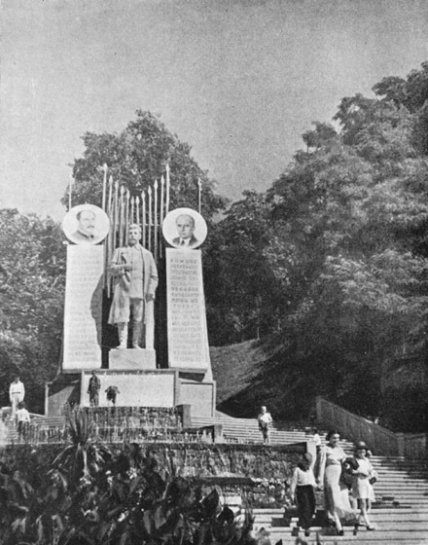The eerie cult of personality: where statues of Stalin once stood in Kyiv and what they looked like (with photos).
The first monument to Stalin was created in 1929 by sculptor Matvey Kharlamov, just before the 50th anniversary of the "leader." The widespread installation of busts occurred during the period of the formation of Stalin's cult of personality, spanning from the mid-1930s to the mid-1950s.
Monuments and busts were erected in most cities of the USSR, and after 1945, in cities of Eastern Europe as well. Larger monuments to Stalin were typically placed in the center of a city, village, or town, often on a central street or square that bore his name.
Smaller monuments to the "leader" were installed in parks, squares, gardens, school grounds, hospital complexes, and on the premises of educational institutions.
The cult of personality surrounding Stalin, constructed by Soviet propaganda, was exposed and "crushed" in 1956 at the 20th Congress of the CPSU. Around the same time, monuments in his honor began to be actively dismantled.
It is interesting and indicative that remnants of this cult can still be found in Russia, where even today, monuments to Stalin are being unveiled.
Where in Kyiv Stalin's monuments stood and what they looked like
 1
1 The first monument to Stalin in Kyiv was built in the late 1930s. At the III International Square, at the entrance to the park, where a monument to Emperor Alexander II once stood, a 5-meter concrete sculpture of Joseph Stalin was erected.
For this purpose, the entrance to the former Merchant's Garden was enhanced with a wide staircase, at the center of which stood the monument to the "leader." A cascade of fountains was arranged in front of it.
It was planned that when the opportunity arose, the concrete monument would be replaced with a bronze one, but this never happened — it was destroyed in 1941 during the Nazi occupation of Kyiv.
Historians believe that the author of the sculpture could be Sergey Merkuryev, the creator of the "candy" Lenin in Bessarabia, which was installed in 1946.
 2
2 In 1944, after Kyiv was liberated from German-fascist troops, the pedestal was again used to erect a monument to Joseph Stalin. On this occasion, the modern European Square was also renamed in honor of Stalin. The monument was temporary, and plans were made to create a more monumental version in the future.
However, it stood only until 1956, when it was demolished following the decision of the 20th Congress of the CPSU.
 3
3 A standard sculpture titled "Lenin and Stalin in Gorky" was also installed in Pioneer Park, which is now known as Mariinsky Park. The monument was made of concrete and depicted Lenin and Stalin sitting face to face on a bench.
The sculpture was dismantled in the late 1950s to early 1960s. Its further fate is unknown.
 4
4 Another standard sculpture called "Gorky Visiting Stalin" was installed in Pioneer Park, now called Khreshchatyk Park, approximately in the area of the Water Museum.
It was made of concrete. Stalin and Gorky also sat face to face on a bench, conversing. Bright flowerbeds surrounded the monument.
The sculpture was dismantled around the early 1950s and is considered lost.
All monuments to Stalin were dismantled during the de-Stalinization process from 1956 to 1961.
 5
5 Let us recall, Joseph Vissarionovich Stalin was a military and political figure of the USSR. Serving as the General Secretary of the Communist Party of the Soviet Union (1922-1953) and head of government (1941-1953), he established a totalitarian system in the USSR and became, in effect, a sole dictator.
He orchestrated mass repressions from 1931 to 1950. According to estimates by Russian state historian V. Zemtsov, 23.77 million people were convicted in the USSR from 1921 to 1953 (the years of Stalin's rule): of these, 6.43 million were sentenced to the highest penalty, and 3.765 million citizens were exiled.
Previously, "Telegraph" reported that there is a luxurious mansion of a countess that at one point turned into a terrifying torture chamber. The Uvarov estate is a monument of local architectural significance, yet horrific events took place within its walls that would chill the blood in one's veins.